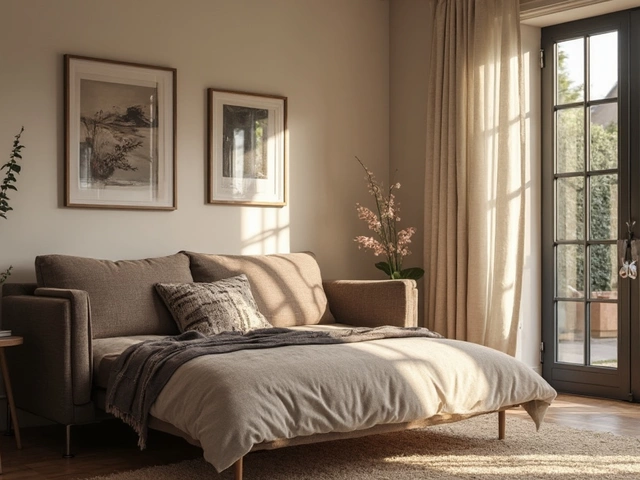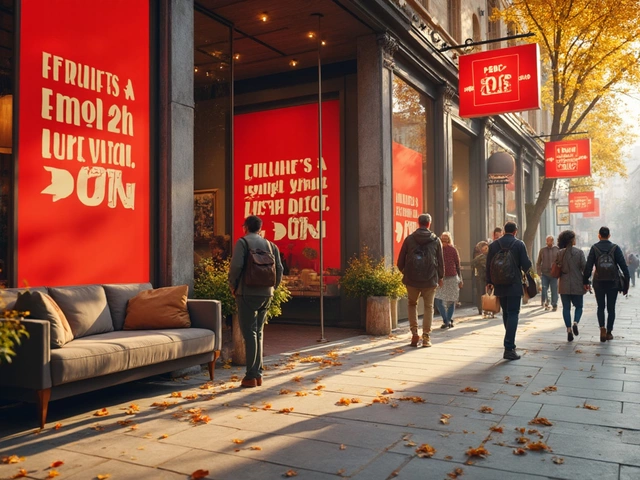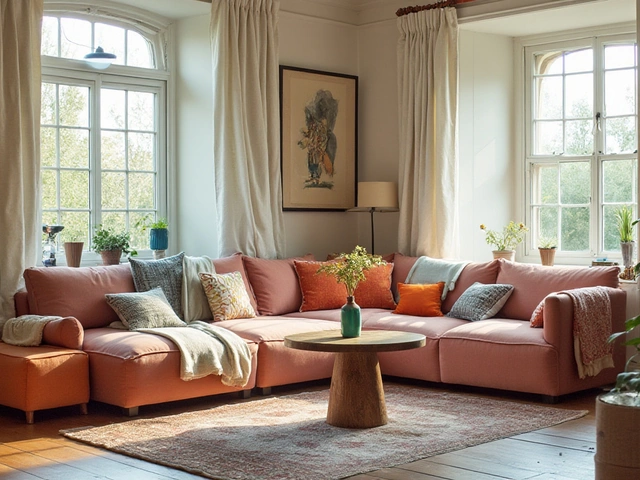 25
May,2025
25
May,2025
Ever sat on a sofa that looked great but felt off the second you plopped down? Happens way too often. A sofa can look stylish in pictures, but the real test is how it feels day after day—and whether it actually survives a few years in your living room.
But here’s the thing: Not all sofas are built the same, even if the price tags look similar. There are brands out there promising “luxury” or “handcrafted” assembly, but sometimes it’s just clever marketing. The real secret? It comes down to the stuff you often can’t see—like what’s inside the cushions, how the frame is put together, and if the company actually stands behind their warranty.
If you want a sofa that doesn’t sag, squeak, or end up with a sinking seat after a few Netflix nights, you need to know what makes one truly top-quality. We’re talking about smart material choices, legit construction techniques, and brands that don’t cut corners. Shopping for a sofa right now? Skip the guesswork. This article breaks down exactly what to look for (and avoid), plus which makers are actually worth your money in 2025.
- What Actually Makes a Sofa 'High Quality'?
- Big-Name Brands vs. Boutique Makers
- What the Materials Say About Quality
- Features and Design Details That Matter
- Tips for Choosing the Best Sofa for Your Space
What Actually Makes a Sofa 'High Quality'?
If you want a strong, comfy sofa that doesn't turn into a lumpy mess, you need to know what separates solid best sofas from the crowd. High quality isn’t about a fancy brand name—it’s about the nuts and bolts you don’t always see.
The best sofas always start with a sturdy frame. Kiln-dried hardwood like oak or maple is the gold standard because it won’t warp or crack over time like cheap particleboard or softwood. Screwed, doweled, and glued joints? That’s what you want. Staples or nails alone? Red flag.
Next, the seat support makes all the difference. Seriously, this is the part that decides if your sofa will sag or stay like new. The best choice is eight-way hand-tied springs—these are literally tied in eight directions and spread weight evenly. Sinuous (S-shaped) springs are good if they’re made from thick steel, but if the couch only has webbing straps, move on.
Don’t skip over the cushions. High-density foam (look for a density rating of at least 1.8 pounds per cubic foot) lasts longer and won’t lose its shape. Some brands wrap foam in down or polyester for extra comfort. Anything super soft and cheap-feeling will break down fast.
- Frame: Kiln-dried hardwood, reinforced joints.
- Springs: Eight-way hand-tied or heavy-gauge sinuous steel.
- Cushions: High-density foam or a foam-down blend.
- Upholstery: Durable fabrics like linen-blend, performance microfiber, or top-grain leather.
For folks who love numbers, check out this table comparing common sofa build features:
| Feature | High-Quality Sofa | Low-Quality Sofa |
|---|---|---|
| Frame Material | Kiln-dried hardwood | Plywood/particleboard |
| Spring Support | 8-way hand-tied/sinuous steel | Simple webbing/no springs |
| Cushion Filling | High-density foam, foam-down | Low-density foam, polyester |
| Upholstery | Performance fabric, leather | Thin fabric, bonded leather |
| Warranty | 10+ years | 1-2 years |
Crazy stat: According to a 2023 industry survey, about 79% of people who bought sofas with kiln-dried hardwood frames still had them in solid shape five years later. If you go for the cheap stuff? Most sagged or broke in under three years.
Bottom line: Ignore the frills and focus on what’s inside. When you know what makes a sofa high quality, you actually get what you pay for—real comfort that lasts.
Big-Name Brands vs. Boutique Makers
When it comes to picking out the best sofas, most people land in one of two camps: team big brand, or team boutique. Each option has its perks—and its pitfalls—so it’s worth getting real about what you’re actually getting.
Big-name brands like IKEA, West Elm, La-Z-Boy, and Ashley Furniture have massive reach. You’ll spot their sofas in showrooms and online catalogs all over the place. What you see is usually what you get: the same piece, built to be affordable, easy to ship, and often backed by fast delivery. But with that scale sometimes comes a compromise on craftsmanship. For example, IKEA’s sofas are loved for value, but they don’t hide the fact that their frames are mostly particleboard and their cushions are standard foam—so you may start seeing sag after a couple of years.
On the other side, boutique makers like Maiden Home, Joybird, or BenchMade Modern put most of their focus into materials and build quality. Sofa frames made of solid kiln-dried hardwood, hand-finished upholstery, and custom sizing aren’t uncommon here. Take Maiden Home: every piece is made-to-order in North Carolina, and their sofas use legit coils and high-resilience foam. Sure, you might wait six to twelve weeks for delivery, but you’re probably getting a sofa that’s going to last well over a decade.
| Brand Type | Average Price Range | Main Materials | Turnaround/Delivery | Typical Warranty |
|---|---|---|---|---|
| Big-Name (e.g. West Elm, IKEA) | $400 - $2,200 | Engineered wood, basic foam | 1-2 weeks | 1 year limited |
| Boutique (e.g. Maiden Home, Joybird) | $1,600 - $5,000+ | Solid hardwood, high-resilience foam | 6+ weeks | Lifetime on frame, 3-5 years on cushions |
If you want something fast and budget-friendly, big brands are usually a safe bet, just set your quality expectations accordingly. But if you’re tired of replacing saggy sofas every five years, a boutique brand might be the smarter investment. Pro tip: Always ask what materials are inside the sofa and the exact warranty details before you hit the buy button—this info should be right on the tag, but you’ll sometimes have to dig for it online with the big brands.
The real kicker? Some big brands are starting to catch on—West Elm and Pottery Barn now offer 'artisan' or 'handcrafted' lines, while some boutique brands offer simplified models for less. It pays to compare, but never skip out on reading full specs or checking what other buyers say about comfort and durability after a few years.

What the Materials Say About Quality
Let’s get real—you can tell a lot about a sofa just by checking what it’s made of. High-quality sofas start with a solid frame. Hardwood like kiln-dried oak, maple, or ash is what you want for strength and long life. If the frame is softwood or, even worse, particle board or plastic, move on. Those cheap materials make sofas wobbly fast.
Next up: suspension. Ask if the sofa uses eight-way hand-tied springs, sinuous (S-shaped) springs, or webbing. Eight-way hand-tied springs take serious work to install and give a comfy, bouncy seat that holds up for years—it’s a gold standard but usually pricier. Sinuous springs are pretty good too, as long as the metal is thick and the springs are close together. But if all you see is webbing, expect the sofa to sag sooner.
Now, those cushions matter big time. The best ones usually have high-density foam (look for at least 1.8 to 2.2 pounds per cubic foot) wrapped in down or polyester. Low-density foam loses shape way faster. Some luxury brands mix foam and down—a cushy combo, but it needs occasional fluffing.
- Best sofas use hard woods, hand-tied springs, and high-density cushions.
- Middle-tier sofas might use quality plywood and sinuous springs, which can work well if the build is solid.
- Low-end sofas often mix particle board with cheap foam and webbing. That’s when you start getting sunken spots and noisy frames after a few months.
When it comes to fabric, natural fibers like cotton and linen feel nice but aren’t as tough as a good synthetic blend. Polyester and poly-blends resist stains and wear, making them smart picks for kids or pets. Leather's the champ for durability, but skip “bonded” or “faux” leather if you want it to last more than a year or two.
Check this table for a quick comparison of popular sofa materials:
| Material | Durability (Years) | Common Use Case |
|---|---|---|
| Kiln-dried hardwood | 15-20+ | Luxury, heavy use |
| Plywood (7-9 layer) | 10-15 | Mid-price, active homes |
| Particle board | 2-5 | Budget, short-term |
| Eight-way hand-tied springs | 20+ | High-end, daily use |
| Sinuous springs | 7-15 | Mid-range |
| High-density foam (2.0+) | 7-10 | All tiers |
| Leather (full grain) | 15-25+ | Premium, pets/kids |
| Polyester blend | 7-15 | Busy families |
Bottom line: Spend some time looking at what your sofa is really made of. You don’t want to replace it after a couple years just because you saved a few bucks at the start. Always check those labels, ask questions about frame and cushion materials, and don’t let fancy marketing distract you from the important stuff.
Features and Design Details That Matter
Digging into what separates an okay sofa from one that’s actually worth the money, it’s all about the details—especially stuff most people miss at a glance. You’re not just buying looks. You want comfort and something that won’t fall apart if you move it twice or host extra friends for a game night.
Start with the frame. Solid hardwood (like oak or maple) is tough to beat. Skip sofas with particleboard or plastic frames—they tend to creak, wobble, and crack. The way the joints are held together matters too. Look for frames that use glued, screwed, and dowelled joints instead of just staples or nails.
Next—cushion filling. High-resilience foam stays springy longer. Some top brands mix foam with down or use pocketed coils for extra support, especially in pricier models. If the seat cushions flatten out fast, you’ll regret it every time you sit down.
Upholstery is another huge factor. Full-grain leather will outlast pretty much anything, but high-quality fabrics like tightly woven polyester blends or performance velvet hold up against spills, pets, and everyday messes. Avoid fabrics that feel thin or snag easily.
Now, about design extras—reversible and removable cushion covers make it way easier to deal with stains or switch things up. Detachable arms, reclining features, or hidden USB chargers aren’t just gimmicks—they can actually make daily life easier. Plus, a sofa with raised legs is easier to vacuum under, which matters more than people realize if you hate dust bunnies.
- Solid hardwood frame (ask if it’s kiln-dried—means better moisture resistance)
- Sturdy joints (dowelled or corner-blocked, not just stapled)
- High-resilience foam or coils in the cushions
- Durable, tightly woven upholstery (bonus points for stain-resistant brands like Crypton or Sunbrella)
- Removable, flippable cushion covers
- Useful extras (USB ports, recliners, easy-to-clean legs or arms)
If you’re comparing options, check out this quick table of common quality features and where different price brackets usually land:
| Feature | Entry-Level Sofas ($300-700) | Mid-Range Sofas ($800-1800) | Luxury Sofas ($2000+) |
|---|---|---|---|
| Frame Material | Plywood/Particleboard | Mixed Woods, Some Hardwood | Solid Kiln-Dried Hardwood |
| Cushion Filling | Basic Foam | High-Resilience Foam, Some Down Mixes | Pocketed Coils, Memory Foam, Down/Feather Blends |
| Upholstery | Standard Polyester/Cheap Fabric | Performance Fabric, Genuine Leather Options | Full-Grain Leather, Premium Fabrics |
| Warranty | 1 Year | 3-5 Years | 10+ Years, Lifetime on Frame Sometimes |
To wrap up—when you’re after the best sofas, look past the color and style for these hidden details. You’ll thank yourself a year down the road when your sofa still feels brand new.

Tips for Choosing the Best Sofa for Your Space
Nailing the right sofa for your home isn’t just about snagging something that looks cool. You’ve got to think about size, comfort, materials, and how everything works in your daily life. Let’s break down the essentials that make shopping way less stressful.
First, take good measurements of your living area before you even browse. Most regrets about sofas come from not double-checking doorways, hallways, or stairwells. According to a 2024 survey by Furniture Today, about 22% of returns happen because the sofa simply wouldn’t fit through the front door. Grab a tape measure and write down your max width, depth, and height, as well as the path from truck to room.
- Best sofas for small spaces: Look for options with slimmer arms or legs. Sofas with storage or modular sections are clutch for apartments and condos.
- Family or pets? Go for stain-resistant fabrics like performance polyester or leather. Newer ‘life-proof’ materials can handle spills better than you’d expect.
- Cushion filling matters. High-density foam or a foam-core wrapped in down holds up better over time than plain poly fill.
- Don’t ignore the frame. Kiln-dried hardwood is strongest—it won’t warp or crack the way softer woods or particleboard can.
If you’re into couches with built-in recliners or techy extras like USB charging, check if those features have solid warranties. More parts mean more things that can break down the road.
| Feature | What to Look For | Why It Matters |
|---|---|---|
| Frame Material | Kiln-dried hardwood | Lasts longer, resists warping |
| Fabric Type | Performance polyester, leather | Easy to clean, resists stains |
| Cushion Filling | High-density foam or foam/down mix | Keeps shape, better support |
| Sofa Width | Measure your entry/path | Prevents delivery headaches |
| Warranty | At least 5 years on the frame | Covers you for defects or breakage |
A few last tips: Always check return policies—especially for custom or online orders. Try a sofa in person if you can; sit in your usual way and see if it feels right. Don’t be afraid to ask about where and how the couch was made. Good brands are proud to explain the details. After all, you’re investing in something you’ll use every day, so a little extra digging now pays off big later.




